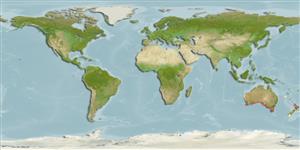>
Blenniiformes (Blennies) >
Clinidae (Clinids)
Etymology: Heteroclinus: Greek, heteros = other + Greek, klinein, kline = sloping and bed, due to the four apophyses of sphenoid bone (Ref. 45335).
More on author: Ogilby.
Environment: milieu / climate zone / depth range / distribution range
पारिस्थितिकी
समुद्री बेनथोपिलाजिक. Temperate
Indo-West Pacific: southern Australia.
आकार / वज़न / Age
Maturity: Lm ? range ? - ? cm
Max length : 10.0 cm TL पुल्लिंग / अलिंग; (Ref. 9002)
पृष्ठीय रीढ़ (सम्पूर्ण) : 29 - 31; पृष्ठीय सौफट रेज़ (सम्पूर्ण) : 3; गुदा कांटा: 2; ऐनल सौफट रेज़: 18 - 21. Pelvic fin rays thick, finger-like (Ref. 9002). Brown or green in color; series of dark blotches dorsally and midlaterally (Ref. 9002).
Commonly in shallow weedy areas in green or brown weeds (Ref. 9002).
Life cycle and mating behavior
Maturities | पुनरुत्पत्ति | Spawnings | Egg(s) | Fecundities | लार्वा
Kuiter, R.H., 1993. Coastal fishes of south-eastern Australia. University of Hawaii Press. Honolulu, Hawaii. 437 p. (Ref. 9002)
IUCN Red List Status (Ref. 130435)
Threat to humans
Harmless
Human uses
साधन
Special reports
Download XML
इंटरनेट स्रोत
Estimates based on models
Preferred temperature (Ref.
123201): 14.3 - 21.2, mean 17.6 °C (based on 325 cells).
Phylogenetic diversity index (Ref.
82804): PD
50 = 0.5000 [Uniqueness, from 0.5 = low to 2.0 = high].
Bayesian length-weight: a=0.00513 (0.00223 - 0.01182), b=3.06 (2.86 - 3.26), in cm total length, based on LWR estimates for this (Sub)family-body shape (Ref.
93245).
Trophic level (Ref.
69278): 3.5 ±0.5 se; based on size and trophs of closest relatives
लौटाव (Ref.
120179): ऊंचा, न्यूनतम जनसंख्या दुगनी समय अवलागत 15 महीने। (Preliminary K or Fecundity.).
Fishing Vulnerability (Ref.
59153): Low vulnerability (10 of 100).
